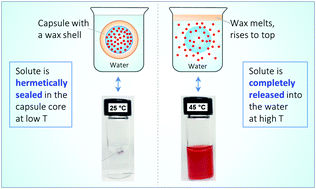Responsive capsules that enable hermetic encapsulation of contents and their thermally triggered burst-release†
Abstract
Aqueous capsules made from polymers typically allow their encapsulated cargo (e.g., drugs, dyes, proteins) to slowly diffuse out into the solvent through the capsule shell. In many applications, there is a need for a ‘hermetic’ seal to protect the cargo from the solvent over extended periods of time. Ideally, this hermetic seal should also be capable of being broken on-demand to enable cargo release. We demonstrate a new design for capsules having the above combination of properties. The key is to create the capsule shell from wax materials (alkanes and fatty acids) with a defined melting temperature Tm. Capsules can be loaded with any desired material, including strong acids or bases, reactive or unstable reagents (such as H2O2), and biopolymer gels. When sealed capsules are placed in water, no leakage is observed for over six weeks. The capsules can also encapsulate volatile liquids and remain air-tight over at least three weeks. On the other hand, under mild heat (above Tm, e.g., to 45 °C), the shell melts, releasing the core contents into the surrounding solvent. This provides a convenient thermal on–off “switch” for delivering contents from the capsules. The utility of these capsules is shown by implementing a nitrate-detection assay using hazardous chemicals (including H2SO4) sealed in the capsules. These “smart” capsules thus constitute a modular, mass-producible platform that could be useful in diverse applications.



 Please wait while we load your content...
Please wait while we load your content...